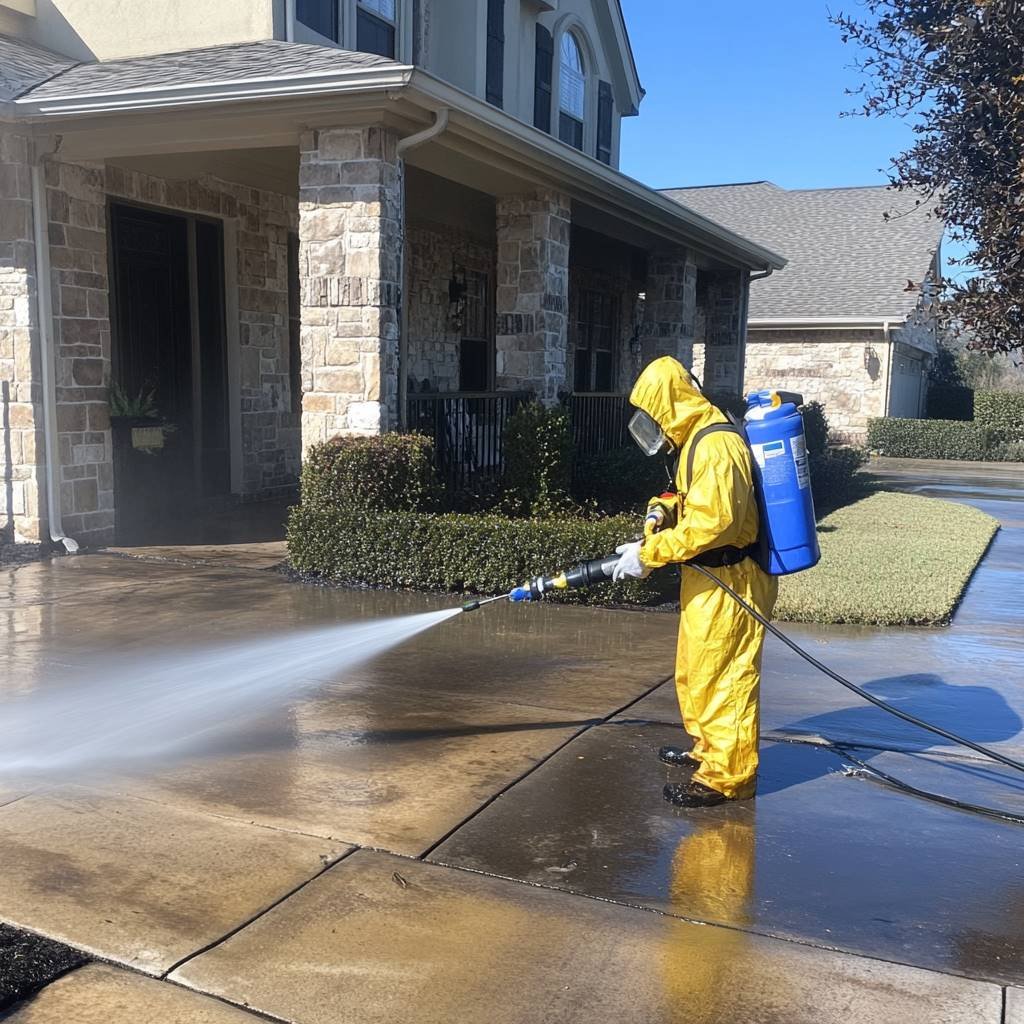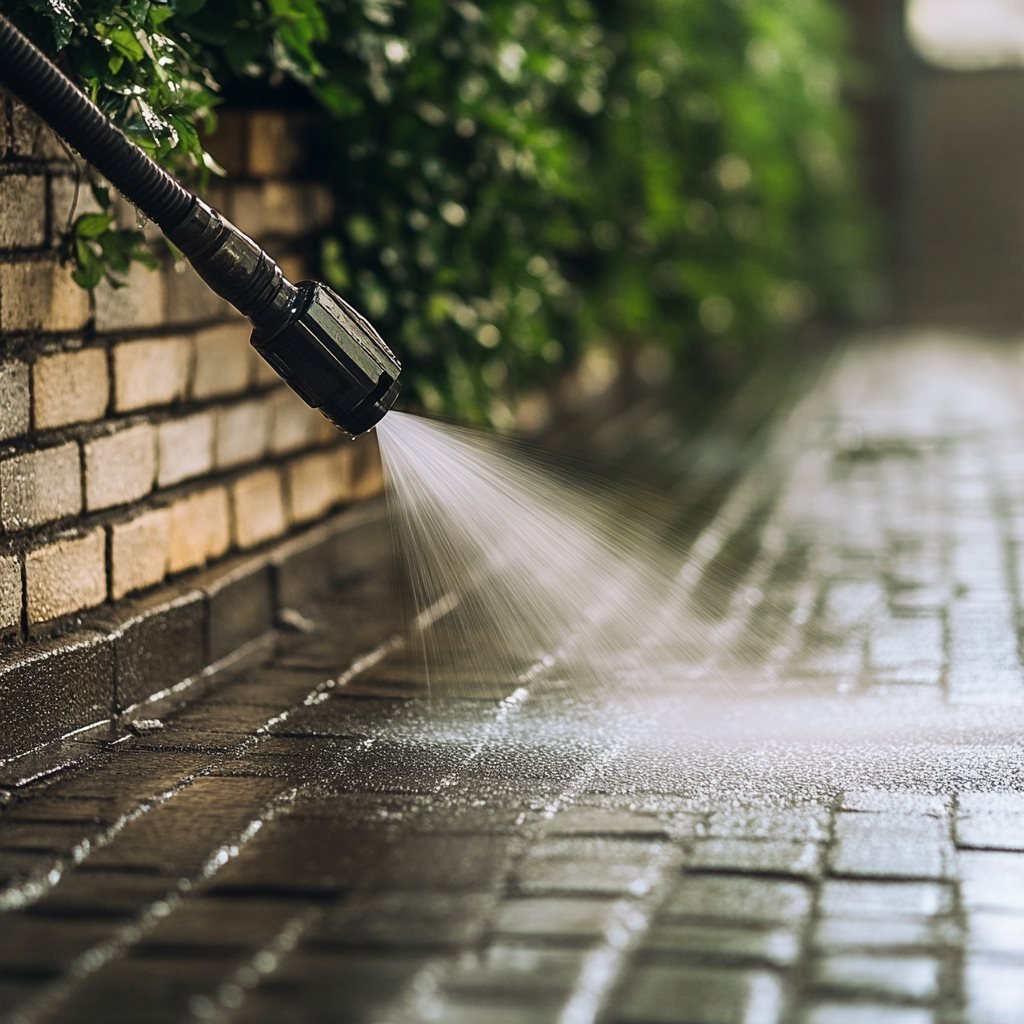Pressure washing is an effective method to help prevent pest infestations by cleaning surfaces and removing pest pheromones and debris that attract bugs and rodents.
Table of Contents
TogglePressurized water can clean hard-to-reach places and make your property less inviting to pests. Dirt, grime, and food particles stuck on surfaces can attract bugs and rodents.
Key Takeaways
- Pressure washing removes debris and pest attractants.
- Focus on cleaning hard-to-reach and commonly infested areas.
- Regular pressure washing helps prevent infestations effectively.
Understanding Pest Infestations

1: Common Pests
Different pests can invade your home or business. Here are some common ones:
- Ants: These insects are often attracted to food crumbs and sugary spills. They can contaminate food and surfaces.
- Termites: Known for damaging wooden structures, termites can seriously compromise the integrity of buildings.
- Rodents: Mice and rats can chew through wires, causing electrical problems, and they also spread diseases.
- Spiders: While some spiders are harmless, others can deliver painful bites and create unsightly webs.
2: Causes of Pest Infestations
Pests often look for three main things: food, moisture, and shelter.
- Food Sources: Leftover food, crumbs, and unsecured garbage attract pests. Clean kitchens and proper food storage can help reduce this problem.
- Moisture: Leaky pipes, standing water, and damp areas can attract pests. Fixing leaks and ensuring proper drainage can help keep them at bay.
- Shelter: Cluttered areas, such as basements or storage rooms, provide hiding spots for pests. Keeping spaces tidy and organized can discourage them from settling in.
By maintaining cleanliness, you can make your property less appealing to pests. Regular cleaning, including pressure washing by Triple Clean Power Washing, can help eliminate food residues and other attractants, reducing the risk of infestations.
Benefits of Pressure Washing

What is Pressure Washing?
Pressure washing uses high-pressure water spray to remove dirt, grime, mold, and other debris from surfaces. Power washing is similar but adds heated water to the mix, making it more effective for removing stubborn substances like oil and grease.
General Benefits
Removing Dirt, Grime, and Mold Regular pressure washing keeps surfaces looking clean and new. By removing buildup, you not only improve the appearance but also extend the life of your property’s exterior.
Pest Prevention Pressure washing clears away debris and organic matter that can attract pests. Keeping your exterior clean helps prevent termites, roaches, and mosquitos from making their home on your property.
Environmental Benefits When done correctly, pressure washing can be environmentally friendly. Using just water or eco-friendly detergents minimizes harmful chemicals. Additionally, it can prevent pollutants like mold and mildew from spreading into the environment.
Maintaining Property Value A well-maintained exterior increases curb appeal and can enhance the overall value of your property. For example, regular cleaning with Triple Clean Power Washing guarantees that your home’s siding, deck, and driveways remain in top condition.
Preventing Long-term Damage By regularly cleaning exteriors, you avoid the long-term damage caused by mold, mildew, and dirt buildup. This regular maintenance can save you money in costly repairs down the road.
Quick and Efficient Pressure washing is a fast and efficient way to clean large surfaces. It saves time and effort, especially when compared to traditional cleaning methods that involve scrubbing and the use of multiple cleaning agents.
Safe for Users, Modern pressure washers are designed to be user-friendly and safe when used according to guidelines. This makes it easy for homeowners to handle their cleaning needs without professional help.
How Pressure Washing Helps Prevent Pest Infestations
Removing Food Sources
Pressure washing is highly effective at removing food residues and organic matter from outdoor surfaces. By using this method, you can clean spots like patios, decks, and garbage areas.
This removal is important because these locations often become breeding grounds for pests due to leftover food and debris. Regular cleaning helps guarantee that pests do not find these appealing.
Eliminating Shelter
Many pests seek out shelters in hidden, moist, and dirty areas. Cleaning gutters, under decks, and other concealed spots can help eliminate these shelters.
Pressure washing these areas keeps them clean and dry, making it less likely for pests to set up residence.
Disrupting Pest Habitats
Pressure washing also works to disrupt nests and habitats. For example, it can remove spider webs, wasp nests, and other structures pests build. By regularly washing surfaces, you actively disrupt these pests and their environments, reducing the likelihood of infestations around your home.
Using Triple Clean Power Washing for these tasks measure up to thorough and efficient results, helping maintain a pest-free environment.
Areas to Focus on for Effective Pressure Washing

Exterior Walls and Sidings
Cleaning your exterior walls and sidings helps remove dirt, mold, and mildew that can attract pests. Make sure to start from the top and work your way down. Use a wide spray to cover large areas quickly. Pay special attention to corners and crevices where bugs can hide.
Driveways and Walkways
Pressure washing your driveways and walkways can clear away debris and spills that may attract pests. Clean surfaces can deter ants and other insects from setting up colonies. To achieve this, aim for an even, thorough wash using a high-pressure setting to remove grime and organic material.
Decks and Patios
Your decks and patios should also be a priority. These areas can collect leaves, food scraps, and other debris. Regular cleaning can prevent pests like ants and wasps from finding food or shelter.
Use a moderate setting to avoid damaging the wood or patio materials, ensuring all gaps and spaces are free of dirt.
Roof and Gutters
Finally, keeping your roof and gutters clean is important. Leaves and twigs in gutters can create nests for pests and promote water damage. Pressure washing helps clear these materials out, preventing pests from finding a foothold.
Always use a lower pressure setting on roofs to avoid damage to shingles and tiles. Make sure gutters are thoroughly flushed for proper drainage.
Best Practices for Pressure Washing to Prevent Pests

Safety Measures
When using a pressure washer, always wear protective gear. This includes gloves, goggles, and sturdy shoes. Make sure the area is free from obstacles and keep children and pets at a safe distance. Safety should always be your first priority.
Choosing the Right Equipment
Select a pressure washer with adjustable settings. Lower PSI settings are ideal for delicate surfaces, while higher settings are better for tough grime.
A washer with various nozzle tips can help in targeting different areas accurately. Triple Clean Power Washing offers a range of suitable equipment for all your needs.
Scheduling Regular Cleanings
Incorporate pressure washing into your routine maintenance schedule. Aim for once every two to three months during peak pest seasons. Regular cleaning prevents the buildup of dirt and residues that attract pests, keeping them at bay.
Professional Services
Sometimes, hiring professionals is the best option. Triple Clean Power Washing provides expert services that make certain the job is done safely and effectively. Consider professional help if you have large areas to clean or if the surfaces are particularly delicate.
Additional Tips to Prevent Pest Infestations
Proper Waste Management
Effective waste management is key to preventing pests. Dispose of garbage regularly and make sure trash bins are covered tightly.
Avoid leaving food scraps and other organic waste out in the open, as these attract pests quickly. Clean the area around your bins to remove any spills or food remnants that could invite unwanted visitors.
Sealing Cracks and Gaps
Sealing cracks and gaps in your home is important to prevent pests from getting in. Inspect your home’s foundation, windows, and doors for any openings. Use caulk or weatherstripping to seal these entry points.
Check around utility lines where pests may sneak through. By sealing these areas, you create a strong barrier against pest entry.






